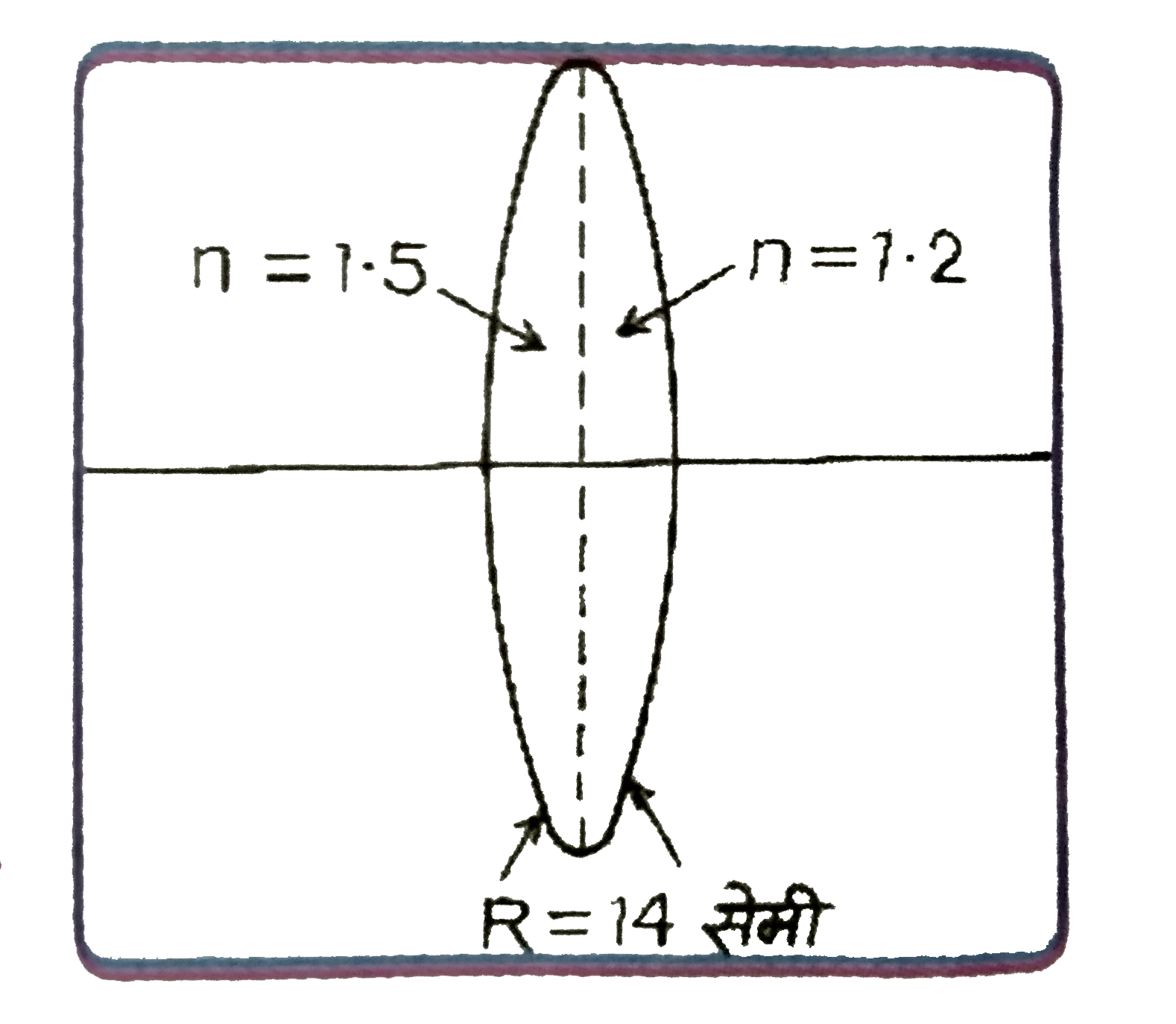A bi-convex lens is formed with two thin plano convex lenses as shown in the figure. Refractive index n of the first lens is 1.5 and that of the second lens is 1.2. Both the curved surfaces are of the same radius of curvature R = 14 cm. For this bi-convex lens, for an object distance of 40 cm, the image distance will be
 Solution in Marathi
Solution in Marathi
−280.0 cm
40.0 cm
21.5 cm
13.3 cm
The correct Answer is:B
Step by step video & image solution for A bi-convex lens is formed with two thin plano convex lenses as shown in the figure. Refractive index n of the first lens is 1.5 and that of the second lens is 1.2. Both the curved surfaces are of the same radius of curvature R = 14 cm. For this bi-convex lens, for an object distance of 40 cm, the image distance will be by Physics experts to help you in doubts & scoring excellent marks in Class 11 exams.
Updated on:21/07/2023Topper's Solved these Questions
- RAY OPTICSBOOK - TARGET PUBLICATIONCHAPTER - RAY OPTICSEXERCISE - EVALUATION TEST
16 Videos
- RAY OPTICSBOOK - TARGET PUBLICATIONCHAPTER - RAY OPTICSEXERCISE - CRITICALTHINKING
38 Videos
- OPTICSBOOK - TARGET PUBLICATIONCHAPTER - OPTICSEXERCISE - EXERCISE
447 Videos
- REFRACTION OF LIGHT BOOK - TARGET PUBLICATIONCHAPTER - REFRACTION OF LIGHT EXERCISE - EVALUATION TEST
15 Videos
Similar Questions
When image is fomred by reflaction, the field of veiw is maximum for
View SolutionA concave mirror is placed on a horizontal table, with its axis directed vertically upwards. Let O be the pole of the mirror and C its centre of curvature. A point object is placed at C. It has a real image, also located at C. If the mirror is now filled with water, the image will be.
View SolutionLight is a form of energy which travels as ________.
View SolutionAssertion : The images formed by total internal reflections are much brighter than those formed by mirrorrs or lenses.
Reason : There is no loss of intensity in total internal reflection.
View SolutionA bi-convex lens is formed with two thin plano-convex lenses as shown in the figure. Refractive index n of the first lens is 1.5 and that of the second lens is 1.2. Both the curved surface are of the same radius of curvature R=14 cm. For this bi-convex lens, for an object distance of 40 cm, the image distance will be
View SolutionA bi-convex lens is formed with two thin plano-convex lenses as shown in the figure. Refractive index n of th efirst lens is 1.5 and that of the second lens if 1.2 Both the curved surfaces are of the same radius of curvature R=14cm. For this bi-convex lens, for an object distance of 40cm, the image distance will be
View SolutionThe radius of curvature of the curved surface of a plano-convex lens is 20cm. If the refractive index of the material of the lens be 1.5, it will
View SolutionIf in a plano-convex lens, the radius of curvature of the convex surface is 10 cm and the focal length of the lens is 30 cm , then the refractive index of the material of lens will be
View SolutionThe radius of curvature of the curved surface of a plano-convex lens is 20cm. If the refractive index of the material of the lens be 1.5, it will
View Solutionएक पतले समतल-उत्तल लेंस की फोकस-दूरी 20.0 सेमी हैं तथा उसके पदार्थ का अपवर्तनांक 1.5 हैं | इस लेंस के उत्तल पृष्ट की वक्रता-त्रिज्या ज्ञात कीजिए |
View Solutionकिसी द्वि-उत्तल लेन्स की वक्रता त्रिज्याये समान है। लेन्स के पदार्थ का अपवर्तनांक 1.5 है यदि लेन्स की फोकस दूरी 30 सेमी हो तो उसकी वक्रता त्रिज्याये ज्ञात कीजिये।
View Solutionचित्र में दर्शाये अनुशार, दो पतले समतल-उत्तल लेन्सों को मिलाकर एक उभयोत्तल लेन्स बना है | पहले लेन्स का अपवर्तनांक (n) 1.5 तथा दूसरे का 1.2 है | दोनों लेन्सों के गोलीय फलको की वक्रता-त्रिज्या R = 14 सेमी है | उभयोत्तल लेन्स के लिये यदि वस्तु की दूरी 40 सेमी हो, तब प्रतिबिम्ब की दूरी होगी :

View Solutionएक उभय-उत्तल लेन्स की दोनों वक्रता त्रिज्याये 40 सेमी है। यदि लेन्स के पदार्थ का अपवर्तनांक 1.5 हो तो लेन्स की फोकस दूरी ज्ञात कीजिये।
View Solutionकिसी द्वि-उत्तल लेन्स की वक्रता त्रिज्याये समान है। लेन्स के पदार्थ का अपवर्तनांक 1.5 है यदि लेन्स की फोकस दूरी 30 सेमी हो तो उसकी वक्रता त्रिज्याये ज्ञात कीजिये।
View Solutionएक द्वि - उत्तल लैंस की शक्ति 10 डायॉप्टर तथा प्रत्येक सतह की वक्रता त्रिज्या 10 cm है । लैंस के पदार्थ का अपवर्तनांक होगा
View SolutionThe radius of curvature of the curved surface of a plano-convex lens is 20 cm. If the refractive index of the material of the lens be 1.5, it will
View Solution
